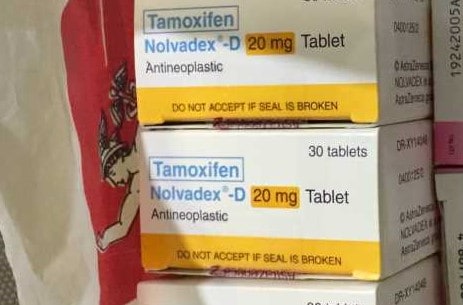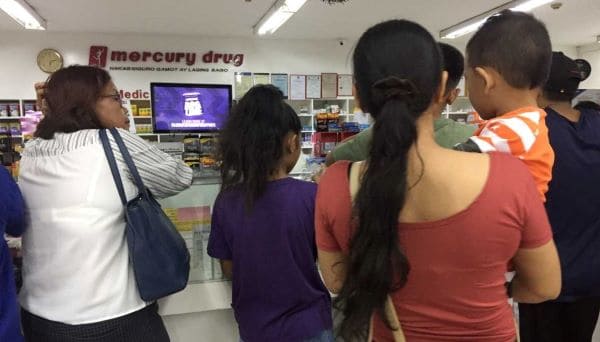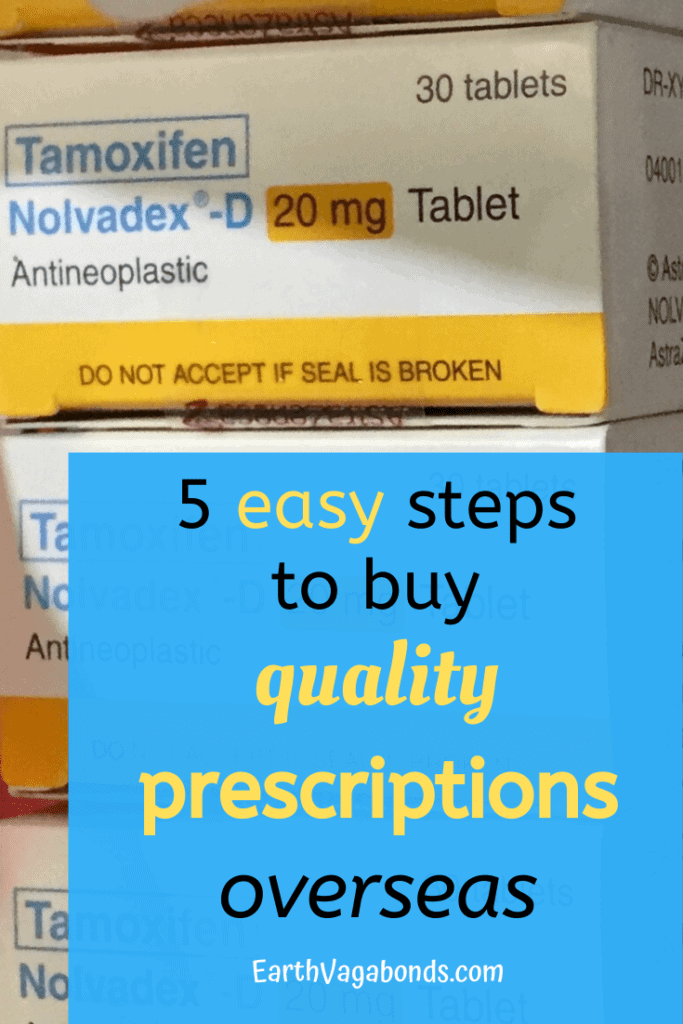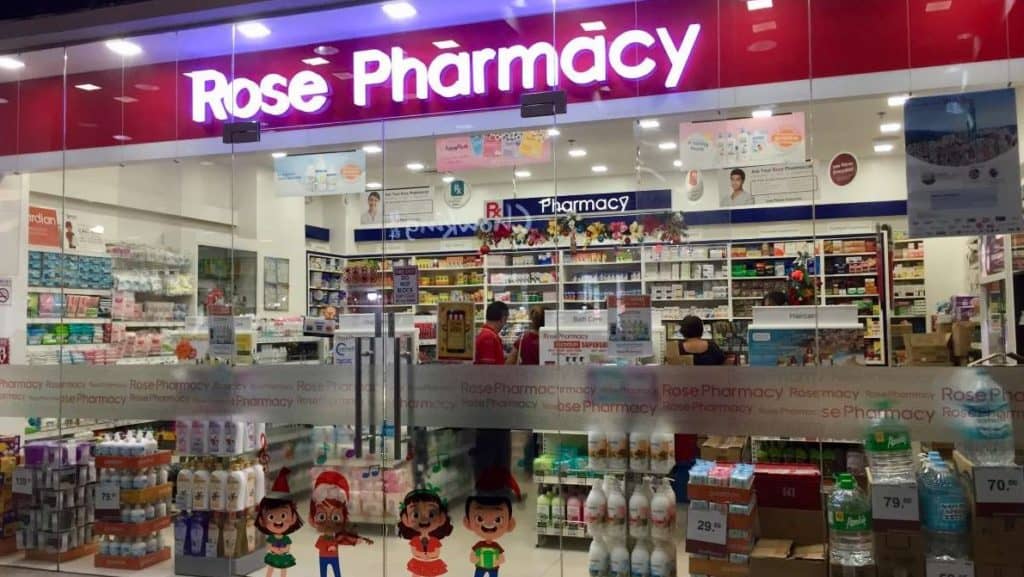Last Updated on May 18, 2025 by Ellen
As more Americans retire or become digital nomads and travel abroad, more of my fellow citizens wonder how to safely buy prescription drugs overseas. This article explains how in five easy steps, based on years of personal experience.
As an American budget slow traveler in early retirement since 2015, and as a breast cancer warrior since 2018, I have often bought different types of prescription drugs overseas. In fact, I’ve done it in several countries.
You get to benefit from my real-world experience.
A disclaimer: I’m not a medical professional and none of this is intended as medical advice. I’m simply sharing my experience on how to buy quality, fairly priced prescription drugs outside the USA.
How to buy prescription drugs overseas
Step 1: Be an open-minded American
Americans have this conception of doctor visits that does not fit reality in other countries. In the U.S., in order to meet your health insurance rules, you have to book an appointment with a doctor — and certainly a specialist — many weeks or months in advance.
That’s not the case in many foreign countries.
In fact, I often have been seen by foreign doctors — and specialists — on the same day I inquire about an appointment. The longest I ever had to wait for an appointment was one week. And I’ve scheduled appointments further out than that because it was my choice, due to our travel schedule.
Step 2: Find a foreign doctor
How do you find a doctor in a foreign country? Ask around!
Use Facebook groups with expats and local people who live in your destination country and region. Inquire about respected doctors and hospital groups.
I give experiential referrals much more weight than some international accreditation program, because the doctor or hospital pays to be on referral lists. Would you rather see a doctor trusted by locals, or a doctor who has paid to be on a list?
Make sure the doctor you chose is fluent in English.
U.S. embassy check
Another tip: use the U.S. State Department’s website. Find the country you will visit, look for the medical assistance section. Almost every country with a U.S. Embassy has this.
There is often a list of medical professionals somewhere in this section.
NOTE: U.S. embassies do not endorse or recommend foreign health care services.
Many embassies share the information as a courtesy to travelers. The info comes from personal experience by fellow Americans, usually embassy personnel and their families.
I have used this list this in many countries, including Mexico, Croatia, and the Philippines. It is always a good source for further investigation. Do your own research, as the saying goes.
Tip for urgency, not emergency
Or, let’s say you feel like you might have something rather urgent, like bronchitis and you feel you may need antibiotics. Some cities have doctor’s offices that will take you right away.
Mexico, for example, has doctors connected with Similares Pharmacies and serve walk-ins.
Step 3: Get your consultation
Once you find a doctor or hospital, how do you book an appointment if you’re not a walk-in patient? Ask!
If you need a fairly routine prescription, such as tamoxifen for breast cancer recurrence prevention, just about any oncologist on the planet will be happy to see you in a consultation to write a prescription.
Some hospitals have international patient desks with staff to specifically help foreigners. This is especially helpful in countries where English is not a primary language. If it’s not possible to see a doctor who is fluent in English, arrange for a translator who is.
Most countries will not accept foreign prescriptions. This is why I always see a doctor in the country I’m visiting when I need a refill.
Office visit prices
Don’t stress about the doctor’s visit price in most counties.
I’ve paid $5 in Mexico for a Chikungunya diagnosis, $10 for a flu diagnosis in the Philippines, $20 for an oncologist visit in Malaysia — and the oncologist was kind enough to give me his personal email! (Remember Step 1?)
If you are scheduling something serious, like surgery, of course your office visit is going to be more expensive. Emergency room visits, too.
But for easy medication orders and routine visits, arranging to see a doctor is so simple and cheap in so many countries compared to the USA.
Afraid of health care overseas? Don’t be!
Our special guide on global health care shows you:
- 7 easy steps to find the right doctors and hospitals
- Specific price examples for various medical services
- What to know about medical visas
- And more!
We go without travel health insurance, but many of the principles apply to those with coverage.
Step 4: Buy prescription drugs overseas at a pharmacy
How do you find the best foreign pharmacy to fill your meds? I’ll give you one guess…
Yep: ask!
Shop around like you would at home. Use those Facebook groups. Ask the prescribing doctor.
And remember, just like at home, hospital pharmacies often are more expensive. But depending on the country, it might be your only choice. However, I bet even hospital pharmacies will still be cheaper than in an American hospital.
Prescription drug names
Sometimes different pharmacies will have different prices and different generic alternatives.
Sometimes, foreign pharmacy chains might not have generic drug names you are familiar with. For example, tamoxifen (cancer recurrence prevention) in different counties is sold under dozens of different brand names. In India alone, there are 28 brands of tamoxifen.
But the original international brand name will be the same — in this case Nolvadex.

Not all pharmacies in developing countries will carry all drugs under any name.
One example is Albania. I could not buy tamoxifen there. Luckily, I had enough supply to get me to Greece, which was our next stop.
Prescription drug availability
To that end, it might help to ask doctors and pharmacies ahead of your visit if they carry the prescription drugs you need. Think regionally, as well as country by country.
For example, in the Philippines, tamoxifen was not readily available in more rural areas, and took a few days or weeks to get the order.

Also keep in mind: pharmacies in developing nations sell prescription drugs by the pill or by foil sleeve — because people are too poor to buy a full month supply at once. Therefore, you might not be able to quickly ‘stock up.’
One more quick tip on pharmacy selection, especially in the tropics. Pick one that has air conditioning.
You don’t want medication degradation due to constant heat and humidity. Every label will tell you that.
Step 5: Reimbursements & picture proof
I take pictures of everything: doctor’s orders, receipts, packaging.
I do this for three reasons:
- Health savings account reimbursements
- I can throw away small receipts and clunky medication boxes
- Proof of prescription drug need
- especially important when crossing borders
We pay out-of-pocket for stuff like this; our health savings accounts can reimburse our medical costs.
As an early retired slow traveler, I’m too young for Medicare, so I don’t know how that works.
But if you plan to work out something with some sort of insurance, you may need to submit picture proof.
Last thought on how to buy prescription drugs overseas
I hope your journey for medical care abroad is as easy and efficient as mine has been.
Even with breast cancer, broken bones, a mosquito virus, and more: I survived – and thrived.
As they say, health is wealth, and it’s necessary for world travel.
Along with a truly open mind, like I said at the beginning of this guide on how to buy prescription drugs overseas.
One day, I’ll see you out here – you’ve got this!
Good luck!
#TravelNow #LifeIsNow

Thanks for reading, “Buy prescription drugs overseas: 5 easy steps.”
Related:
- How to find a surgeon overseas
- What a CAT scan cost in Thailand
- What an emergency room visit cost in Thailand
Popular:
- 12 Best places in the world to retire on small budgets
- How to shortcut proof of onward travel – legally
- What progressive eyeglasses cost in the Philippines
Just for fun:

